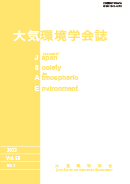
- Issue 6 Pages 87-
- Issue 5 Pages A135-
- Issue 4 Pages A101-
- Issue 3 Pages 67-
- Issue 2 Pages 47-
- Issue 1 Pages 1-
- |<
- <
- 1
- >
- >|
-
Kazuo Osada, Shinichi Koyama, Katsuhiro Ohtsuka, Junya Hoshi, Chieko N ...2023 Volume 58 Issue 3 Pages 67-73
Published: March 27, 2023
Released on J-STAGE: March 27, 2023
JOURNAL FREE ACCESSVolatile organic compounds (VOCs) are important precursors of ozone and secondary aerosol particles in the atmosphere. We developed a battery-powered VOC passive automatic sampler (VPAS) switching device that can automatically expose and store passive VOCs solvent desorption (VOC-SD) samplers. The device can hold eight samplers at any one time. The exposure time is programmable from 1 to 99 h. A strong linear relationship was observed between the mass of the VOCs collected in the VOC-SD samplers and the product of the exposure time and atmospheric concentration (as measured by the analysis of the canister samples). The uptake rates obtained from the relationship were similar to those reported in previous studies. The VPAS will be useful in air-quality research, particularly for determining VOC sources, and will enable the measurement of VOC concentrations in remote areas where commercial alternating-current power is not available.
View full abstractDownload PDF (2086K) -
Chisato Kimura, Yu Morino, Tatsuya Nagashima, Shin Araki, Kayo Ueda, T ...2023 Volume 58 Issue 3 Pages 74-85
Published: March 31, 2023
Released on J-STAGE: March 31, 2023
JOURNAL FREE ACCESSBecause the concentrations of atmospheric ozone (O3) are often overestimated by chemical transport model (CTM) simulations, a bias correction is useful when applying CTMs to evaluations of the environmental impacts of O3. In this study, we used the CTM results for the hourly O3 distribution over Japan during 2012, and we used the O3 observations in 2012 to evaluate three different methods of model bias correction. These consisted of two statistical methods and one machine learning (ML) method. Although all three methods significantly reduced the model bias in reproducing the observed hourly O3 concentrations, the ML method also improved the scores of the mean error and correlation coefficient. We also evaluated the model performance for the daily maximum 8-hour average (DMA8h) O3 and for the accumulated exposure to O3 above a threshold of 40 ppbv (AOT40). The ML method performed the best in both DMA8h and AOT40. Our findings suggest that the ML method could consistently reduce the model bias and error of the O3 indices, thus improving the evaluation of impacts of O3 on human health and crop yields.
View full abstractDownload PDF (4356K)
-
Michio Kawamiya2023 Volume 58 Issue 3 Pages A91-A100
Published: May 10, 2023
Released on J-STAGE: May 10, 2023
JOURNAL RESTRICTED ACCESSDownload PDF (1530K)
- |<
- <
- 1
- >
- >|